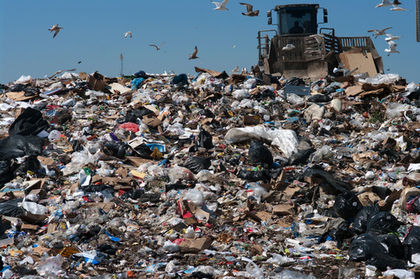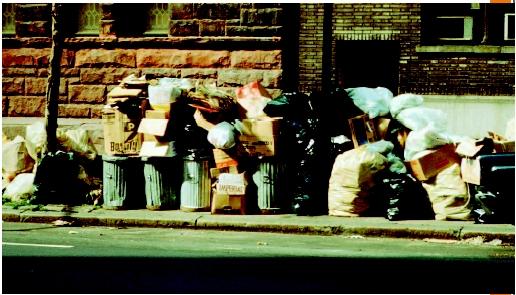Waste

Waste has been defined as a moveable object with no direct use that is discarded permanently. There are many different kinds of waste, including solid, liquid, gaseous, hazardous, radioactive, and medical. Wastes can also be

Waste Types
A solid waste does not flow like water or gas. Examples include paper, wood, metals, glass, plastic, and contaminated soil. Solid wastes can be hazardous or nonhazardous. Problems associated with nonhazardous solid waste include aesthetic problems (litter and odors), leachate from the infiltration of water through the waste, and off-gases resulting from biodegradation. Nonhazardous solid wastes are commonly handled by recycling, combustion, land-filling, and composting.
Liquid wastes must be transported in containers or through pipes. Examples include sewage, contaminated groundwater, and industrial liquid discharges. In some cases, direct discharge to the environment may be allowed. However, depending on the waste's characteristics, direct discharge may cause unacceptable environmental harm. For example, large amounts of sewage discharged into a stream can result in fish kills. Liquid wastes containing excreta can contain pathogenic organisms. Other liquid wastes may be toxic. Liquid wastes are often handled at wastewater treatment plants, followed by discharge to the environment.
Sludges contain various ratios of liquid and solid material. They generally result from liquid waste-treatment operations, such as sedimentation tanks. Depending on the percent of solids, sludge may have the characteristics of a liquid or solid. Biological sludge can contain pathogenic organisms. Some sludges contain heavy metals or other toxins. Sludges are commonly handled with treatment, combustion, landfilling, and land application.
Gaseous wastes, of course, consist of gases. They are primarily generated by combustion (e.g., internal combustion engines, incinerators, coal-fired electrical generating plants) and industrial processes. Depending on their characteristics, gaseous wastes can be odiferous or toxic. Some are implicated in global warming, ozone depletion, and smog. Gaseous wastes may be released to the atmosphere or captured/treated with pollution control equipment.
Hazardous wastes pose a substantial present or potential danger to human health or the environment. They can be solid, sludge, liquid, or gas. Hazardous wastes have at least one of the following characteristics: corrosivity, ignitability, reactivity, and toxicity. Hazardous wastes are commonly handled by recycling, combustion, stabilization, chemical-physical-biological treatment, and landfilling.
Radioactive wastes emit particles or electromagnetic radiation (e.g., alpha particles, beta particles, gamma rays, and x rays). Radioactive wastes can be high level, transuranic, or low level. High-level radioactive wastes are from spent or reprocessed nuclear reactor fuel. Transuranic wastes are from isotopes above uranium in the periodic table. They are generally low in radioactivity, but have long half-lives . Low-level wastes have little radioactivity and can often be handled with little or no shielding. Radiation can damage living cells and cause cancer. Although recycling and incineration may reduce waste amounts, the primary method for handling radioactive wastes is long-term storage.
Medical wastes, that is, wastes generated at medical facilities, can be infectious, toxic, and/or radioactive. Though they may have hazardous characteristics, they are not regulated as hazardous wastes. Some medical wastes are sterilized, disinfected, or incinerated, especially infectious wastes. Recycling and landfilling are also used to dispose of them.
Waste Amounts
The amount of waste generated by a given household is directly related to lifestyle, culture, and economic status. Climate can also increase generation rates (e.g., yard waste). General differences are great enough to produce different country-wide generation rates. The United States has the highest rate, 2.0 kilograms per person per day—probably the result of high economic status, a culture of consumption, and a lifestyle that includes large amounts of disposable items. However, the United States also has a relatively high recycling rate, 27.8 percent in 1999. Some European countries have generation rates varying from 0.9 to 1.7 kilograms per person per day. Developing regions tend to have still lower rates, ranging from 0.3 to 1.
SEE ALSO A IR P OLLUTION ; H AZARDOUS W ASTE ; L IFESTYLE ; M EDICAL W ASTE ; O ZONE ; R ADIOACTIVE W ASTE ; S OLID W ASTE ; W ASTE TO E NERGY ; W ASTE, T RANSPORTATION OF ; W ASTEWATER T REATMENT .
Bibliography
Davis, M., and Cornwell, D. (1998). Introduction to Environmental Engineering, 3rd edition. New York: WCB McGraw-Hill.
Reinhardt, P., and Gordon, J. (1991). Infectious and Medical Waste Management. Chelsea, MN: Lewis Publishers.
Siegel, M. (1993). "Garbage and Other Pollution—How Do We Live with All the Trash?" Information Plus. Detroit, MI: Gale.
Tchobanoglous, G.; Theisen, H.; and Vigil, S. (1993). Integrated Solid Waste Management. New York: McGraw-Hill.
Jess Everett
Comment about this article, ask questions, or add new information about this topic: